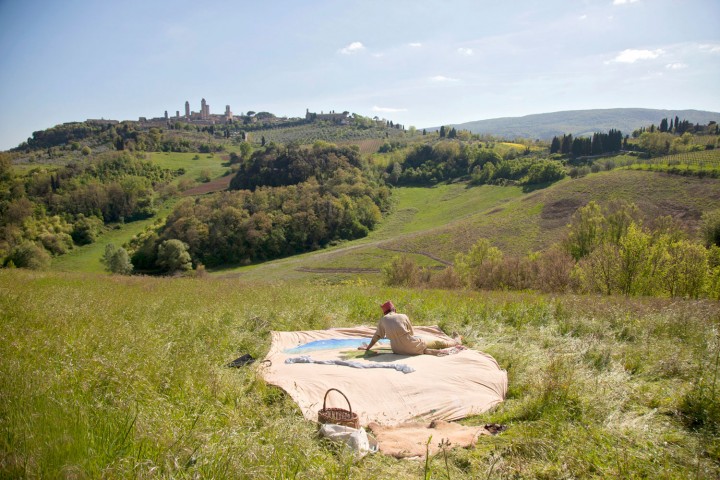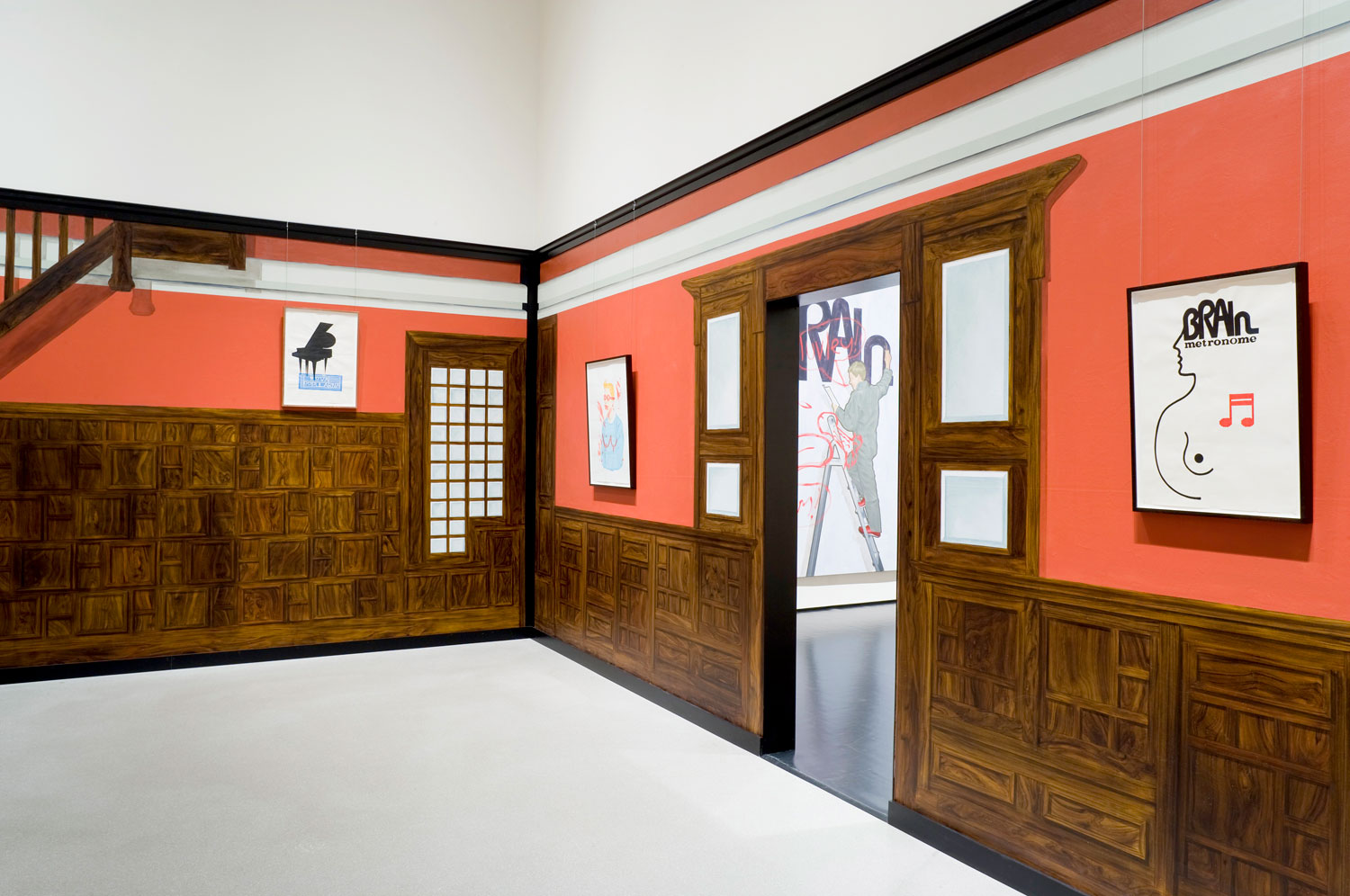
Rajesh Punj: Your performative work seems to directly engage the viewer and draw them out of their comfort zone. Are you seeking to envelope people with your performances?
Nikhil Chopra: Yes, to surround them, to transport them, to hold them captive, many things. Whereas a theater audience would be seated, I allow them to stand and touch, to come close to the performer and the objects so that they can negotiate with the space and be in the performance. All performances are very different. For my Bombay performances, the audience had to enter the space and leave the same way. It was a leaning, rubbing, tactile kind of space; a warehouse in central Bombay in which the audience was able to sit on the bed, to handle the chair as a prop and to enter and leave at will. Whereas in the New York space the objects were not to be touched; it quickly became a vitrine-like space with a huge piece of glass. There the audience had to make a conscious decision to enter the space. My audiences make a clear choice about what kind of audience they want to be: a voyeuristic audience, or an audience on view. Both examples encouraged different settings and very different situations.
RP: Who are your performative influences?
NC: Cindy Sherman, Joseph Beuys.Others who have initiated this leap of faith are Marina Abramovic´ and Eleanor Antin. I can recall a studio visit from Eleanor Antin when I was in grad school; she asked why I was not pushing particular ideas much further, especially those relating to performance. Also early video work: Bruce Nauman, Paul McCarthy, Dan Graham, Vito Acconci, Chris Burden. I had a real interest in performance art history. Japan, Neo-Dada, Europe, works by Hermann Nitsch; the Actionists were also incredibly relevant for me.
RP: Tell me about your occupation and re-creation of ancestral figures.
NC: The idea of persona entering my physical form interests me very much. The persona comes from a relationship to my ancestry. I deliberately pick up strands of history for a story; I pick up notions of postcolonial and colonial history as I dress up as a gentleman. All of my realities get mixed up, as they all get put into one pot and then performed. For me it is important to be this sadistic gentleman, to rub him into the ground, bring him to his knees, in a sense to consciously enter into this duality: to play master and servant, to be part of the past and the present, hero and villain, to play maharajah and coal miner, to play grandfather and son. To be naked and dressed up. This duality, these opposite poles in my performances are what interest me immensely.
RP: Having witnessed one of your performances for the “Indian Highway” exhibition at the Serpentine Gallery, London, 2008, can I ask what was the original premise for that performance, and also what has proved to be the overriding mantra for your practice beyond that?
NC: The task of making a drawing, the rigor and practice of making a vast, epic drawing. Even if they are visual and physically loud, they are so much about the experience of solitude and silence and the need for that focus to make a drawing happen, to perform a drawing as an event; that repeated action of drawing leads to a point of knowing or deciding when the drawing is “finished.” The drawing is an extension of my performative action and also of the performative moment — the nature of this medium allows for self-awareness. The presence of a mirror, as in New York, makes you suddenly very self aware of every action and every gesture you attempt. That self-awareness can become a mantra, which is enduring. I am interested to a degree in the idea of suffering, like climbing a mountain. There is a sense of exhilaration to climbing a mountain. The audience, upon entering the performance, are invited to feel that, because that is where the spectacle lies. I propose an enduring invitation, an ongoing event, and there is an exhalation to be had in that moment of realization. I am convinced there is a mental strength that needs to be transmitted — in partnership with the audience — if they stay for long enough.

RP: You become utterly central to your work and exhaust yourself for your practice; on occasion your audience fears for your well-being. Do such efforts have more value than those of a painter or sculptor?
NC: I don’t think a painter going into his studio feels detached from his work; at the end of the day it’s a performance, it’s a show, and all of your subsequent feelings are the result of a performance. A deep sense of melancholia comes from any performance, from the impossibility of the task, a sweet sadness; but all of it is not for me, it isn’t me there. You’re meant to feel sad for the persona. After I’m done with the performance I might shout, “Where is that beer?” I want to allow myself to be bad again, almost as an affirmation of my being myself again. The performance is a show. It is real but it is an exhibition and it isn’t how I live myself, I have to confess. I am actually very comfortable in my performances. I always dress warm; super good food, goose pillows, blankets. I positively am a quiet diva
RP: How have your performative works been received internationally?
NC: The audiences depend entirely on the space much more than where I am within it. The audience experiences something very different at every single location. For example, at the theater festival in Brussels, the audience comes with the expectation to see something and wants to watch a spectacle that they have settled into their seats for, whereas an art audience at an major art fair will allow one minute to stand and stare at you. Public spaces do allow for something else entirely. The audience in a public space assume they can come up and ask me something during a performance, as opposed to a museum space in which an audience encircle me as I become their animated exhibit. That audiences will be looking at it from a critical perspective, whereas in a public space they are looking at it as entertainment
RP: Given that you regularly take on the persona of someone else, an ancestral relative, do you ever feel that you are them and they are you? Are you more of the past than the present?
NC: I am fully aware of where my persona ends and I begin; with a performance I am seeking to do away with the self while wanting to awake an alternative persona. The performance is always in the present. I deal with actual given circumstances — costumes, signs that allude to the past. But it is not so much about embodying the past; I am interested in the tension of evoking the past. Myself, I am more of the present than the past. I am more past-present than future-present. I live in the present but do recall and consider the past immensely useful.
RP: Who initially took you on? Noticed your work and gave you a platform?
NC: I performed for the first time at grad school. After grad school, I was desperate to put my ideas out there in the wide world. I had met Chatterjee and Lal in Mumbai, but I did not approach them to put on a show at the time. I borrowed money from my father and put together “Sir Raja III,” a show with photographs and a performance, and the response from an enthusiastic Mumbai audience was encouraging — critical and curious. After this show I was actually approached by Chatterjee and Laland we became partners. It was at Khojin New Delhi,during a performance art residency in early 2007, that I did my first major performance, and from that came the idea of doing a gallery solo show.
RP: Can you expand on your 2011 work at the Pompidou and the direction for your practice since?
NC: At the Pompidou I played with the idea of using the word “white.” The performance was pared down: I made drawings in charcoal on a temporary wall in front of the glass window that overlooked the Paris skyline dominated by Montmartre. A tiny window was cut into the wall; peering through it allowed me to remake the Paris skyline in charcoal. It was a three-day performance, very much about the body and drawing. I do acquire objects, costumes — I have a new costume designer in Berlin that I work with — but in Paris the show wasn’t prop heavy. Pared down, it was a slight departure, but it is important to move away from what I am comfortable with.





